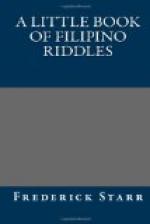Riddles are common to all mankind. They delighted the old Aryans and the ancient Greeks as they do the modern Hindu and the Bantu peoples of darkest Africa. Many writers have defined the riddle. Friedreich in his Geschichte des Raethsels, says: “The riddle is an indirect presentation of an unknown object, in order that the ingenuity of the hearer or reader may be exercised in finding it out.... Wolf has given the following definition: the riddle is a play of wit, which endeavors to so present an object, by stating its characteristic features and peculiarities, as to adequately call it before the mind, without, however, actually naming it.”
The riddles of various Oriental peoples have already been collected and more or less adequately discussed by authors. Hebrew riddles occur in the Bible, the best known certainly being Samson’s:
“Out of the eater came
forth meat,
And out of the strong came
forth sweetness.”
Arabic riddles are many and have been considerably studied; Persian riddles are well known; of Indian riddles at least one collection has been printed separately under the name Lakshminatha upasaru, a series of Kolarian riddles from Chota Nagpur has been printed as, also, an interesting article upon Behar riddles; Sanskrit riddles are numerous and have called for some attention from scholars; a few Gypsy riddles are known; two recent papers deal with Corean riddles. We know of but two references to Malayan riddles; one is Rizal, Specimens of Tagal Folk-Lore, the other is Sibree’s paper upon the Oratory, Songs, Legends, and Folk-Tales of the Malagasy. This is no doubt an incomplete bibliography but the field has been sadly neglected and even to secure this list has demanded much labor. It suffices to show how deeply the riddle is rooted in Oriental thought and indicates the probability that riddles were used in Malaysia long before European contact.
To what degree Filipino riddles are indigenous and original is an interesting but difficult question. So far as they are of European origin or influenced by European thought, they have come from or been influenced by Spain. Whatever comparison is made should chiefly, and primarily, be with Spanish riddles. But our available sources of information regarding Spanish riddles are not numerous. We have only Demofilo’s Collecion de enigmas y adivinanzas, printed at Seville in 1880, and a series of five chap-books from Mexico, entitled Del Pegueno Adivinadorcito, and containing a total of three hundred and seven riddles. Filipino riddles deal largely with animals, plants and objects of local character; such must have been made in the Islands even if influenced by Spanish models and ideas. Some depend upon purely local customs and conditions—thus numbers 170, 237, etc., could only originate locally. Some, to which the answers are such words as egg, needle and thread, etc., (answers common to riddles in all European lands), may be due to outside influence and may still have some local or native touch or flavor, in their metaphors; thus No. 102 is actually our “Humpty Dumpty sat on a wall;” the Mexican form runs:




